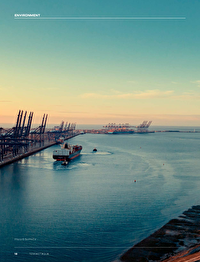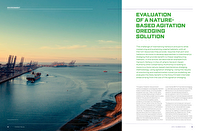Throughout the world, many ports and harbours lie adjacent to ecologically important areas of coastal habitat, providing valuable ecosystem services. These include: highly productive areas feeding large numbers of predatory birds; feeding, spawning and nursery areas for fish populations; absorption of nutrients and improving water quality; protection of the coast from flooding and erosion; efficient carbon sinks, contributing significantly to the sequestration of global carbon dioxide and provision of livelihoods to communities from shellfisheries to tourist industries. The deepened areas of these approaches and berths of these ports and harbours are often associated with siltation, maintenance dredging and offshore disposal away from the coastal system where the dredging takes place. In the UK, 40-50 million cubic metres (Mm3) of maintenance dredging is undertaken every year (Ausden et al., 2018). While some of this maintenance material is placed at licensed disposal sites within estuary systems, most of this material is placed offshore at licenced disposal sites and only around 1% is used to recharge and restore coastal habitats (Ausden et al., 2018).
The deposition and consequent removal of sediment from the maintained areas of ports and harbours can reduce sediment supply, which may result in long-term impacts resulting from depletion of sediment within a coastal system (e.g. Spearman et al., 2014). Even where offshore disposal does not adversely influence the coastal system, there is now a growing international consensus that maintenance material is a resource that can and should be used to promote sustainability of coastlines given the global threat of climate change and sea level rise. This consensus is manifested by the wealth of initiatives to align coastal development with nature, often expressed as “Engineering with Nature” (https://ewn.erdc.dren.mil) or “Building with Nature” (https://building-with-nature.eu), and the growth in beneficial use of dredged material (for instance around 30% of all dredged material in the US, Gailani, 2019). More recently, the sediment management pledge issued jointly by NavClimate, PIANC and the SEDNET network (SEDNET, 2021) during COP26, has resulted in a body of ports, stakeholders, engineering contractors and consultants committing to capitalise on the use of sediment for promoting nature, reducing emissions and exploiting sediment’s carbon storage properties.
COP26 sediment management goals
The COP26 sediment management pledge builds on ideas that have been developing for some time (e.g. IADC 2009, OSPAR 2014; CEDA, 2019). The idea is that more critical thinking about port management of dredging, building in consideration of ecology (in its own right) and the positive influence of ecology on coastal defence, can result in a win-win of minimising the overall costs of development to both nature and human society. When the economic importance of these wider considerations are included in decisions about development, the optimal options are often much more “nature-orientated” (Bridges et al., 2015; Laboyrie et al., 2018).
The COP26 sediment management goals highlight the need to promote, where possible, the restoration and creation of habitat, especially those leading to coastal resilience, noting that it is these same habitats that act as a valuable carbon store; and secondly they highlight a commitment to reducing the energy expended in the management of safe navigation. These goals infer a natural pattern of progress, where ports move from traditional approaches to maintenance dredging without consideration of maintenance material as a resource; to a more enlightened position where traditional maintenance operations are accompanied by beneficial use wherever feasible. Therefore moving to a position where the maintenance operations themselves are designed to maximise benefits for nature (and by extension coastal defence) while minimising use of CO2. This progression will take time as knowledge is gained and the needs of opposing stakeholders are reconciled and not every port will be able to progress fully along this path. While all ports will have scope to improve, some may be constrained to some extent by their environments, significant economic considerations or particular stakeholder concerns.
Case study
This case study is about the Stour/Orwell estuary system in the UK where the conservancy authority is looking to move to a more nature-based and low-carbon maintenance dredging methodology, using agitation dredging. Using the results of monitoring as well as sophisticated and well-validated numerical modelling, we evaluate the effectiveness of the agitation dredging methodology and the likely benefit to the intertidal areas of the Stour/Orwell system through its use.
The Stour/Orwell estuary system
Figure 1 shows the Stour/Orwell system. The estuary system has a low fluvial input – the mean total fluvial discharge into the Stour and Orwell Estuaries is less than 5 cubic metre per second (m3/s), based on Environment Agency data and the UK National River Flow Archive. The tidal range is meso-tidal (3.6 metres (m) mean spring tidal range at the estuary mouth). Waves inside the estuary system are locally wind-generated (Spearman et al., 2014) although within Harwich Harbour (which is the name given to the confluence of the Stour and Orwell Estuaries, at the estuary mouth) swell waves propagate from offshore. Typical wave heights are 0.2 - 0.3 m in the Stour and 0.1-0.2m in the Orwell (HR Wallingford, 1994). However, during strong westerly winds, waves can rise up to 1 m throughout much of the Stour Estuary. Waves in the Orwell Estuary are generally lower because of the reduced fetch lengths (Spearman et al., 2014).






















